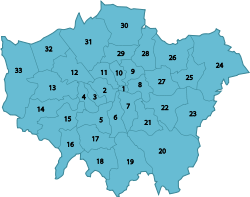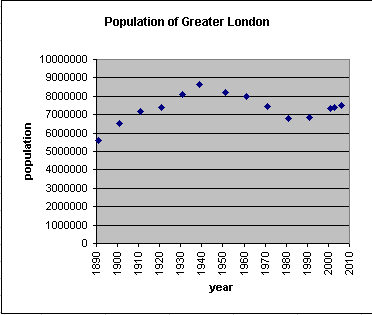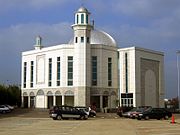
Greater London
About this schools Wikipedia selection
This content from Wikipedia has been selected by SOS Children for suitability in schools around the world. To compare sponsorship charities this is the best sponsorship link.
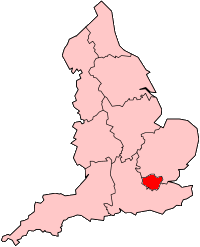 London region shown within England |
|
| Geography | |
|---|---|
| Status | Region* Administrative area Ceremonial county† |
| Area — Total |
Ranked 9th 1,572 km² 607 sq mi |
| NUTS 1 | UKI |
| Demographics | |
| Population — Total — Density |
Ranked 2nd 7,753,600 (mid-2009) 4,932/km2 (12,773/square mile) (mid-2009) |
| GVA per capita | £{{{gva}}} ( {{{gva_rank}}}) |
| Government | |
| Admin HQ | City Hall, Southwark |
| Assembly — Type |
London Assembly directly elected |
| Regional development | LDA |
| Authority | Greater London Authority |
| Mayor | Boris Johnson |
| European parliament | London |
| Website | |
| Notes | |
| * called London † excluding the City of London |
|
Greater London is the top-level administrative subdivision covering London, England, United Kingdom. The administrative area was officially created in 1965 and covers the City of London, including Middle Temple and Inner Temple, and the 32 London boroughs (including the City of Westminster). Its area also forms the London region of England and the London European Parliament constituency. The region has by far the highest GDP per capita in the United Kingdom. It covers 1572 km2 (607 square miles) and had a 2009 mid-year estimated population of 7,753,600. The term Greater London was in use before 1965 to refer to a variously defined area, larger than the County of London and often similar to the Metropolitan Police District.
History
Instead of forming a single political unit, London is divided into the small, interior City of London and the much wider Greater London. This arrangement has come about because as the area of London grew and absorbed neighbouring settlements, a series of administrative reforms did not fully amalgamate the City of London with the metropolitan area, and its unique political structure was retained. Outside the limited boundaries of the old city, a variety of arrangements governed the wider area since 1855, culminating with the creation of the Greater London administrative area in 1965.
| “ | London became a greater and still greater accumulation of towns, an immense colony of dwellings where people still live in their own home in small communities with local government just as they had done in the Middle Ages. | ” |
|
— Steen Eiler Rasmussen, 1934 |
||
Origins
The term Greater London had been used well before 1965, particularly to refer to the area covered by the Metropolitan Police District (such as in the 1901 census), the area of the Metropolitan Water Board (favoured by the London County Council for statistics), the London Passenger Transport Area and the area defined by the Registrar General as the Greater London Conurbation.
The Greater London Arterial Road Programme was devised between 1913 and 1916. One of the larger early forms was the Greater London Planning Region, devised in 1927, which occupied 1,856 square miles (4,810 km2) and included 9 million people.It was historically known as Englon.
Royal Commission on London Government
Although the London County Council had been created as a London-wide authority covering the County of London in 1889, the County did not even cover all the built-up area of London then, particularly West Ham and East Ham; furthermore many of the LCC housing projects, including the vast Becontree Estate, were constructed outside its formal boundaries.
London County Council pressed for an alteration in its boundaries soon after the end of the First World War, noting that within the Metropolitan and City Police Districts there were 122 housing authorities. A Royal Commission on London Government was set up to consider the issue. London County Council proposed a vast new Greater London, somewhere between the Metropolitan Police District and the entire Home Counties. Protests were made at the possibility of including Windsor, Slough and Eton in the authority.
The Commission made its report in 1923, rejecting the LCC's scheme. Two minority reports favoured change beyond the amalgamation of smaller urban districts, including both smaller borough councils and a Central Authority for strategic functions. The London Traffic Act 1924 was a result of the Commission.
Creation of administrative area
Reform of the local government arrangements in the County of London and its environs was again considered by the Royal Commission on Local Government in Greater London. Greater London was formally created by the London Government Act 1963, which took force on 1 April 1965, replacing the former administrative counties of Middlesex and London, adding the City of London, which was not under the London County Council, and absorbing parts of Kent, Surrey, Essex and Hertfordshire.
Greater London originally had a two-tier system of local government, with the Greater London Council (GLC) sharing power with the City of London Corporation (governing the small City of London) and the 32 London borough councils. The Greater London Council was abolished in 1986 by the Local Government Act 1985. Its functions were devolved to the Corporation and the London boroughs with some functions transferred to central government and joint boards.
Greater London Authority
Greater London was used to form the London region of England in 1994. A referendum held in 1998, established public will to create a regional authority. The Greater London Authority, London Assembly and the directly elected Mayor of London were created in 2000 by the Greater London Authority Act 1999.
The 2000 and 2004 mayoral elections were both won by Ken Livingstone, who had been the final leader of the GLC. The 2008 election was won by Boris Johnson the Conservative Party candidate. In 2000 the outer boundary of the Metropolitan Police District was re-aligned to the Greater London boundary.
Geography
Greater London is bounded by the home counties of Essex and Hertfordshire in the East of England region and Buckinghamshire, Berkshire, Surrey and Kent in South East England. The highest point in Greater London is Westerham Heights, in the North Downs and on the boundary with Kent, at 245 metres (804 ft).
The area of Greater London has not changed significantly since its creation. There have been a considerable number of small boundary changes. The most significant of these were the 1969 transfers of Knockholt to Kent and Farleigh to Surrey and a series of minor adjustments during the 1990s which realigned the boundary to the M25 motorway in some places. The majority of Greater London forms the London low emission zone from 4 February 2008.
Governance
Greater London is not a city in the proper sense that the word applies in the United Kingdom, that of being a status granted by the Crown. In addition, one of the London boroughs, Westminster, is already a city, as well as the City of London itself which would make such a status anomalous. Despite this, Greater London is commonly regarded as a city in the general sense of a municipality. A Lord Lieutenant of Greater London is appointed for its area, less the City of London, an area identical to the Metropolitan Police District, and for the purposes of the Lieutenancies Act 1997, this area is defined as a county.
The term "London" is normally used in reference to Greater London or to the overall conurbation, but not often to the ancient, tiny City of London. Instead, this small area is often referred to simply as "the City" or "the Square Mile" and it forms the main financial district. Archaically the urbanised area of London was known as the Metropolis. In common usage, the terms "London" and "Greater London" are usually used interchangeably. It is officially divided for some purposes, with varying definitions, into Inner London and Outer London. For strategic planning purposes the region is divided into five sub regions.
Regional government
London is the only English region with directly elected local governance. The Greater London Authority (GLA) comprises a regional assembly called the London Assembly and an executive head known as the Mayor of London.
The current Mayor of London (not to be confused with the Lord Mayor of the City of London) is Boris Johnson. He is scrutinised by an elected London Assembly, which may amend his annual budget (by two-thirds majority) but otherwise lacks the power to block his directives. The headquarters of the GLA is at City Hall in Southwark. The Mayor is responsible for Greater London's strategic planning and is required to produce a London Plan document.
Local government
Greater London is divided into 32 London boroughs, each governed by a London borough council; and the City of London, which has a unique government dating back to the 12th century. These various authorities are all often considered as equivalent to unitary authorities, but not legally defined as such.
All London borough councils belong to the London Councils association. Two London boroughs, Kensington and Chelsea, and Kingston, carry the purely honorific title of Royal borough. Within the City of London boundary are the liberties of Middle Temple and Inner Temple.
|
|
London Assembly
For elections to the London Assembly, London is divided into fourteen constituencies. The constituencies are formed from the area of two or three boroughs combined. The City of London forms part of the City and East constituency.
UK Parliament
London is divided into 73 Parliamentary constituencies, which are all small borough constituencies. They are formed from the combined area of several wards from one or more London Boroughs. Typically a single borough is covered by two or three constituencies.
Demography
| 2011 United Kingdom Census | |
|---|---|
| Country of birth | Population |
| 5,175,677 | |
| 262,247 | |
| 158,300 | |
| 129,807 | |
| 114,718 | |
| 112,457 | |
| 109,948 | |
| 87,467 | |
| 84,542 | |
| 66,654 | |
| 66,654 | |
| 66,311 | |
| 65,333 | |
| 63,920 | |
| 62,050 | |
| 62,896 | |
| 59,596 | |
| 55,476 | |
| 53,959 | |
| 44,848 | |
| 44,199 | |
| 41,041 | |
| 39,817 | |
| 39,452 | |
| 37,339 | |
| 35,880 | |
| 26,435 | |
| 21,039 | |
With increasing industrialisation, London's population grew rapidly throughout the 19th and early 20th centuries, and was the most populated city in the world until overtaken by New York in 1925. Its population peaked at 8,615,245 in 1939. There were an estimated 7,753,600 official residents in Greater London as of mid-2009.
However, London's continuous urban area extends beyond the borders of Greater London and was home to an estimated 9,332,000 people in 2005, while its wider metropolitan area has a population of between 12 and 14 million depending on the definition of that area. According to Eurostat, London is the most populous city and metropolitan area of the European Union.
The region covers an area of 1,579 square kilometres. The population density is 4,761 people per square kilometre, more than ten times that of any other British region. In terms of population, London is the 25th largest city and the 17th largest metropolitan region in the world. It is also ranked 4th in the world in number of US dollar billionaires residing in the city. London ranks as one of the most expensive cities in the world, alongside Tokyo and Moscow.
Ethnic groups
In the 2001 census, 71.15% of these seven and a half million people classed their ethnic group as white, including the White British (59.79%), White Irish (3.07%) or "Other White" (8.29%, mostly Greek and Turkish Cypriot, Italian and French). 12.09% classed themselves as British Asian, including Indian, Pakistani, Bangladeshi and "Other Asian" (mostly Sri Lankan, Arab and other Southern Asian ethnicities).
10.91% classed themselves as Black British (around 7% as Black African, 3% as Black Caribbean, 0.84% as "Other Black"). 3.15% were of mixed race; 1.12% as Chinese; and 1.58% as other (mostly Filipino, Japanese, Korean, Vietnamese and other "British Orientals"). 21.8% of inhabitants were born outside the European Union. The Irish, from both the Republic of Ireland and Northern Ireland, number about 200,000, as do the Scots and Welsh combined.
In January 2005, a survey of London's ethnic and religious diversity claimed that there were more than 300 languages spoken and more than 50 non-indigenous communities with a population of more than 10,000 in London. Figures from the Office for National Statistics show that, as of 2006, London's foreign-born population is 2,288,000 (31%), up from 1,630,000 in 1997. The 2001 census showed that 27.1% of Greater London's population were born outside the UK, and a slightly higher proportion were classed as non-white.
The table shows the top 21 countries of birth of London residents in 2001, the date of the last UK Census. Note that a portion of the German-born population are likely to be British nationals born to parents serving in the British armed forces in Germany. Note also that these figures do not give a fair indication of the total population of the specific ethnic groups associated with each country.
For example, Londoners of Greek origin (from both Greece and Cyprus) who reside in Greater London number 300,000, since an organised Greek community has been established for nearly two centuries. The same can be said for Italian and French Londoners whose communities have been here for centuries. By contrast, while a Polish community has existed in London since the late Middle Ages, only in the 21st century did this community grow significantly (its approximate size was 50,000 in 2008).
London has been a focus for immigration for centuries, whether as a place of safety or for economic reasons. Huguenots, eastern European Jews and Cypriots are examples of the former; Irish, Bangladeshis and West Indians came for new lives. The East End district around Spitalfields has been first home for several ethnic groups, which have subsequently moved elsewhere in London as they gained prosperity.
The largest ethnic-minority communities are the Jamaican in Brixton, Hackney and Tottenham; West African in Southwark and Lewisham; Indians in Ealing, Brent, Harrow, Hounslow, Redbridge, Newham and Hillingdon; Pakistani and Bangladeshi in Newham, Tower Hamlets, Waltham Forest, and Barking & Dagenham; Tamil in Wembley and Tooting; and East African and Caribbean in Harlesden and Stonebridge. A sizeable Italian community live in the Enfield area of Freezywater and close by at Waltham Cross and Cheshunt
Population
The population on the current territory of Greater London rose from about 1.1 million in 1801 (back then only about 0.85 million people were in the urban area of London, while 0.25 million were living in villages and towns not yet part of London) to an estimated 8.6 million in 1939, but declined to 6.7 million in 1988, before starting to rebound in the 1980s.
As of 2006, the population in Greater London has only recovered the level of 1970 (which was also the level of population in the 1920s). Some researchers expect the population of Greater London to reach 8.15 million by 2016, which would still be 0.45 million short of the 1939 peak.
Figures here are for Greater London in its 2001 limits. Figures before 1971 have been reconstructed by the Office for National Statistics based on past censuses in order to fit the 2001 limits. Figures from 1981 onward are midyear estimates (revised as of August 2007), which are more accurate than the censuses themselves, known to underestimate the population of London.
| 1891 | April 5/6 | 5,572,012 |
| 1901 | 31 March/April 1 | 6,506,954 |
| 1911 | April 2/3 | 7,160,525 |
| 1921 | June 19/20 | 7,386,848 |
| 1931 | April 26/27 | 8,110,480 |
| 1939 | Midyear estimate | 8,615,245 |
| 1951 | April 8/9 | 8,196,978 |
| 1961 | April 23/24 | 7,992,616 |
| 1965 | Greater London formally created | |
| 1971 | April 25/26 | 7,452,520 |
| 1981 | Midyear estimate | 6,805,000 |
| 1988 | Midyear estimate | 6,729,300 |
| 1991 | Midyear estimate | 6,829,300 |
| 2001 | Midyear estimate | 7,322,400 |
| 2002 | Midyear estimate | 7,361,600 |
| 2003 | Midyear estimate | 7,364,100 |
| 2004 | Midyear estimate | 7,389,100 |
| 2005 | Midyear estimate | 7,456,100 |
| 2006 | Midyear estimate | 7,512,400 |
Wider population
Greater London is not exactly coterminous with London's built up area and a somewhat wider Greater London Urban Area has been defined and is used for mainly statistical purposes. London's wider metropolitan area is known as the London commuter belt and is delimited by a variety of definitions.
Economy
This is a chart of trend of regional gross value added (GVA) of Inner London at current basic prices published (pp. 240–253) by Office for National Statistics with figures in millions of British Pounds Sterling.
| Year | Regional Gross Value Added | Agriculture | Industry | Services |
|---|---|---|---|---|
| 1995 | 64,616 | 7 | 8,147 | 56,461 |
| 2000 | 92,330 | 6 | 10,094 | 82,229 |
| 2003 | 112,090 | 12 | 10,154 | 101,924 |
This is a chart of trend of regional gross value added of Outer London at current basic prices published (pp. 240–253) by Office for National Statistics with figures in millions of British Pounds Sterling.
| Year | Regional Gross Value Added | Agriculture | Industry | Services |
|---|---|---|---|---|
| 1995 | 44,160 | 51 | 10,801 | 33,307 |
| 2000 | 60,304 | 43 | 12,529 | 47,732 |
| 2003 | 67,582 | 39 | 13,081 | 54,462 |
Religion
The largest religious groupings in London are Christian (58.2%), those of no religion (15.8%), Muslim (8.2%), Hindu (4.1%), Jewish (2.1%), and Sikh (1.5%). London has traditionally been Christian, and has a large number of churches, particularly in the City. The famous St Paul's Cathedral in the City and Southwark Cathedral south of the river are Anglican administrative centres, while the head of the Church of England and worldwide Anglican Communion, the Archbishop of Canterbury has his main residence at Lambeth Palace in the London Borough of Lambeth.
Important national and royal ceremonies are shared between St Paul's and Westminster Abbey. The Abbey is not to be confused with nearby Westminster Cathedral, the largest Roman Catholic cathedral in England and Wales. Religious practice in London is lower than in any other part of the UK or Western Europe and is around seven times lower than American averages. Despite the prevalence of Anglican churches, weekly observance is low within that denomination, although in recent years church attendance, particularly at evangelical Anglican churches in London, has started to increase.
London is also home to sizeable Hindu, Muslim, Sikh, and Jewish communities. Many Muslims live in Tower Hamlets and Newham; the most important Muslim buildings are the East London Mosque in Whitechapel, the London Central Mosque on the edge of Regent's Park and the Baitul Futuh Mosque in Morden. London's large Hindu community is found in the north-western boroughs of Harrow and Brent, the latter of which contains one of Europe's largest Hindu temples, Neasden Temple.
Sikh communities are located in East and West London, which is also home to the largest Sikh Temples in the world, outside India. The majority of British Jews live in London, with significant Jewish communities in Stamford Hill (the most Orthodox Jewish area outside New York City and Israel) and St. John's Wood, Golders Green, and Edgware in North London.
Education
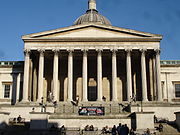
The education system has been split into the thirty three separate LEAs, which correspond to the City of London, the City of Westminster and the 32 London boroughs, since the 1990 enactment of the Education Reform Act 1988. From 1965 to 1990, twelve Inner London boroughs and the City of London had been served by an Inner London Education Authority.
The introduction of comprehensive schools, directed by Circular 10/65 in 1965, was mostly followed in Greater London, however 19 grammar schools have been retained in some Outer London boroughs, with Sutton having the most with five, followed by Bexley with four and others in five other boroughs. In these boroughs the state schools outperform the (relatively few) independent schools. In inner London, private schools always get the best results and are larger in number. At GCSE and A level, Outer London boroughs have broadly better results than Inner London boroughs.
At GCSE, the best borough is Kingston upon Thames, closely followed by Sutton. Both boroughs have selective schools, and get the top two average GCSE results in England for LEAs. Next is Kensington and Chelsea, the third best in England, then Redbridge, Hammersmith and Fulham, Bromley, Barnet and Harrow. Only ten boroughs have GCSE results under the England average, and some inner-London boroughs have surprisingly good results considering where they lie on the scale of deprivation, e.g. Lambeth. Overall at GCSE in 2009, Greater London had the best results for regions of England. Greater London is generally a prosperous region, and prosperous areas generally have good GCSE results. The City of London has no state schools, just two independent schools. Haringey and Kensington and Chelsea have the most people that pass no GCSEs.
However at A level, the average results for LEAs are disappointing, compared to their good GCSE results. Although Kingston upon Thames gets the best GCSE results in England, at A-level it is not even above average. Sutton gets the best A-level results in London and in England. Three of the schools in the top four at A-level in London are in Sutton. It has only one independent school. The few other boroughs with above-average A-level results are Havering, Barnet, Bexley, Redbridge, and Ealing. The poor A-level results in many London boroughs is explained by the quantity of independent schools getting good A-level results. The state school system is often bypassed at age 18 by the more able pupils. Some London boroughs need more good sixth form colleges.
The region's thirty four FE colleges are administered by five LSC areas, and the region's LSC main office based in Centre Point. The three main FE colleges are Kingston College, Havering College of Further and Higher Education, and Croydon College.
Top twenty state schools in Greater London (2009 A level results)
The three comprehensives in the list are from Hammersmith and Fulham, Waltham Forest and Havering.
- 1. Wilson's School, Wallington (1202)
- 2. The Tiffin Girls' School, Kingston upon Thames
- 3. Nonsuch High School for Girls, Cheam, Sutton
- 4. Wallington County Grammar School, Sutton
- 5. St. Michael's Catholic Grammar School, North Finchley, Barnet
- 6. Queen Elizabeth's Grammar School for Boys, Barnet
- 7. St. Olave's and St. Saviour's Grammar School, Orpington, Bromley
- 8. Sutton Grammar School for Boys
- 9. Tiffin School, Kingston upon Thames
- 10. Sacred Heart of Mary Girls' School, Upminster, Havering
- 11. Newstead Wood School for Girls, Orpington, Bromley
- 12. The Henrietta Barnett School, Hampstead Garden Suburb, Barnet
- 13. The Latymer School, Edmonton, Enfield
- 14. Townley Grammar School for Girls, Bexleyheath, Bexley
- 15. Ilford County High School, Barkingside, Redbridge
- 16. St Dominic's Sixth Form College, Harrow on the Hill, Harrow
- 17. Chingford Foundation School, Chingford, Waltham Forest
- 18. Woodford County High School, Woodford Green, Redbridge
- 19. Lady Margaret School, Parsons Green, Hammersmith and Fulham
- 20. Bexley Grammar School, Welling, Bexley (891)
Universities
The University of London has twenty federated colleges and schools. The main three higher education institutions (HEIs) are (in order of total funding) University College London (UCL), Imperial College London, and King's College London. KCL and UCL are part of the University of London, and Imperial College was part of this university until 2007, and is now an independent university. UCL and Imperial have very large research grants - some of the largest in England after Cambridge and Oxford. KCL also has a large research grant, and one of the largest in England. The next largest institution by funding is Queen Mary, University of London. The top three institutions get more than twice as much total income than any other institution in the region, with UCL and Imperial around £600 million each. The region has many medical schools, and one vet school, the Royal Veterinary College (which also has a main site at North Mymms in Hertfordshire) in Camden. The RVC has the lowest drop-out rate in the region.
By student numbers, the top five universities are London Metropolitan University, the University of Westminster, Middlesex University, the University of Greenwich, then City University London.
For students in the region, 50% come from the region, and around 30% from other regions. For students from other regions, most come from South East England, the East of England, and, to a lesser degree, South West England; the vast majority are from the south of England. For students native to the region, over 50% stay in the region, with 15% going to South East England, then around 5% going elsewhere, except Scotland, Wales and the North East. Once graduated, over 70% stay in the region; London is a mecca (though expensive) for graduates from all over the UK. Just under 15% go to the South-East, and just over 5% go to the East of England; very few go anywhere else.
Twinning
The Greater London Authority has twin and sister city agreements with the following cities.
| Country | City | County / District / Region / State | Date | |
|---|---|---|---|---|
| China | Beijing | Beijing Municipality | 2006 | |
| France | Paris | Île-de-France | ||
| Germany | Berlin | Berlin | 2000 | |
| Russia | Moscow | Central Federal District | ||
| United States | New York City | New York | 2001 | |
| Japan | Tokyo | Tokyo | 2005 |
For Borough twinning see List of twin towns and sister cities in the United Kingdom#London.


